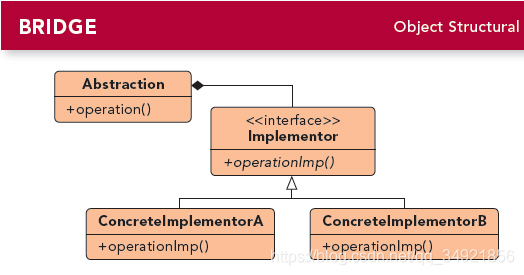Bridge(桥接) — 对象结构型模式
将一部分结构分离出去,使得对象和该部分结构能够自由的组合。听起来是不是很迷糊,举个例子,现在想要生成一个带颜色的图形,图形有长方形,圆形等等。那么我应该将颜色作为一个类分离出去,图形作为另一个类。
适用场景
- 你不希望在抽象部分和它部分实现(抽象部分:图形,部分实现:颜色)之间有一个固定的绑定关系。例如,这种情况可能是因为,在程序运行时实现部分应可以被选择或者切换。
- 抽象部分和部分实现都应该可以通过生成子类的方式加以扩充。这时 Bridge 模式使你可以对不同的抽象接口和实现部分进行组合。
- 对一个抽象的实现部分的修改应对客户不产生影响,即客户的代码不必重新编译。
UML图

效果
- 一个实现未必不变的绑定在一个接口上,抽象类的实现可以在运行时进行配置,一个对象甚至可以在运行时改变它的实现。
- 将 Abstraction 与 Implementor 分离有助于降低对实现部分编译时的依赖性,当改变一个实现类时,并不需要重新编译 Abstraction 类和它的客户程序。为了保证一个类库的不同版本之间的二进制兼容性,一定要有这个性质。
- 调高可扩充性:可以独立地对 Abstraction 和 Implementor 层次结构进行扩充。
- 实现细节对客户透明,可以对客户隐藏实现细节,例如共享 Implementor 对象相应的引用计数机制 (如果有的话)
示例
class Graphics(object):def __init__(self, color_implementor):self.color_implementor = color_implementordef draw(self):raise NotImplementedErrorclass Rectangle(Graphics):def draw(self):print("this is a {} rectangle".format(self.color_implementor.get_color()))class Round(Graphics):def draw(self):print("this is a {} round".format(self.color_implementor.get_color()))class ColorImplementor(object):def get_color(self):raise NotImplementedErrorclass GreenImplementor(ColorImplementor):def get_color(self):return "green"class OrangeImplementor(ColorImplementor):def get_color(self):return "orange"client
if __name__ == "__main__":rec1 = Rectangle(GreenImplementor())rec1.draw()rec2 = Rectangle(OrangeImplementor())rec2.draw()round1 = Round(GreenImplementor())round1.draw()round2 = Round(OrangeImplementor())round2.draw()""" output: this is a green rectangle this is a orange rectangle this is a green round this is a orange round """